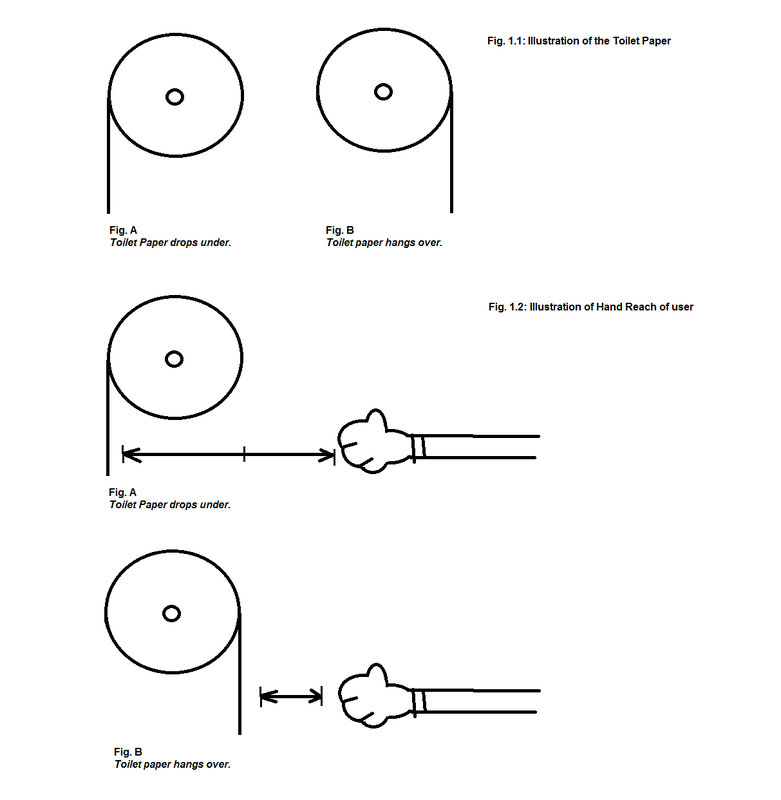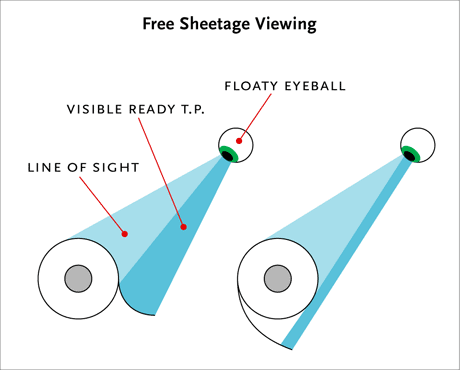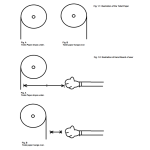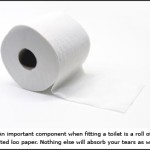There is only one right answer to this conundrum: which way should the toilet roll hang – over the top or under the bottom? The answer of course is over the top, for reasons explained eloquently in this article:
Essential Life Lesson #1: Over is Right, Under is Wrong
As part of our ongoing effort here at Current Configuration to make your life not only better, but also 10% more crunchy, we’re offering you this first installment of what will be an ongoing series of Essential Life Lessons. Kicking off this series will be a critical but even-handed examination of a common misunderstanding that occurs in a realm of many misunderstandings: the bathroom.
Put simply, there is a right way to hang the toilet paper, and a wrong way. Read on to determine the status of your own roll.
Toilet paper has a natural curve, a way of being that lends itself to certain orientations on the toilet paper spool.* If handled with skill and knowledge, it can provide an abundance of both sanitation and comfort, quilted together in each square of pillowy ply. If handled with clumsy ignorance, or worse, carelessness, it will beset the user with pain, filth, and frustration. Don’t let it end this way, with you curled on the tile floor of the stall, weeping in frustration, covered in wasted papier de toilette. To convince you, we’ve created some diagrams, harnessing the power ofSCIENCE, to demonstrate the natural benefits of the over hanging method. First, we examine the optimal viewing benefits of the over hanging method.
Below are examples of the helpful and fruitful over-hung method on the left and the annoying and detrimental under-hung method on the right.
Notice the dramatic difference in the amount of visible toilet paper. Ironically, it is the over-hung toilet paper that has both the most visible free sheetage and the least amount of sheetage free from the roll to do it. Now, this may not seem like a big deal on its own, but in these extra sheets lies your undoing. Observe.
We here at Current Configuration, for the purposes of ease and expediency, do the one-handed tear (okay, really, it’s just me, but bear with me, er, us). The one-handed tear is a quick maneuver that takes advantage of the perforated squares, allowing your bundle of toilet paper to be liberated with one quick swipe of the arm. This is thefoundation of bathroom ease, the cottony bedrock on which enjoyment rests in the restrooms of many nations.
The one-handed tear relies on a quick and forceful motion directed either away from or towards the tear-er. The forces applied in this motion are great and, like the atom, are not to be trifled with. The natural curve of the over-hung method allows the roll to stand fast after a one-handed tear, but the under-hung method creates a calamitous tendency in the roll. This tendency can only lead to this:
Wasted paper, frustration, the destruction of our forests. While we realize that it is possible to execute a one-handed tear on an under-hung roll, this is a game of sanitary Russian roulette. You are bound to lose eventually, and there is no re-rolling an unwound toilet paper roll. The results will only cause you grief. Don’t let this happen to you. Restroom attendants, janitors, maids, facilities crews, and responsible toiletowners take note: Don’t use the under-hung method for your toilet paper rolls. It leads to the destruction of our precious resources and the pillars of civilization as we know it!
*Does that thing have a proper name?
IMPORTANT UPDATE: Because you demanded it, we bring you theOverhanging Public Service Hanger Brochure.
However, given the perversity of human nature, some people will always think differently! American consumer surveys typically find 60-70% of the public prefer over, as indeed do hotels, but that there is a significant minority who go with under. Reasons often stated are:
- Under provides a tidier appearance, in that the loose end can be more hidden from view.
- Under reduces the risk that a toddler or a house pet, such as a dog or cat, will completely unroll the toilet paper when batting at the roll.
- Under in a caravan or motorhome may reduce unrolling during driving.
There is more to this than sheer reason, though. Various studies have pointed to the sociological ritualised behaviour element to this, and that it provokes furious debate in some quarters. Toilet roll, yes I know!
Others will doubtlessly be bored rigid by the whole debate and think we should move on to something more relevant. And they are probably right, but next time you see a toilet roll going under, think to yourself: someone has put it that way, and probably for their own reasons!










